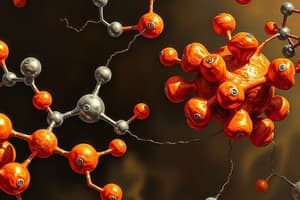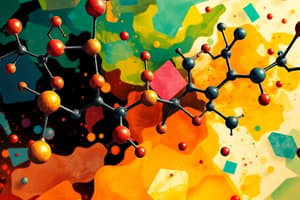Podcast
Questions and Answers
What process typically breaks down macromolecules into monomers?
What process typically breaks down macromolecules into monomers?
Which of the following is true regarding carbohydrates?
Which of the following is true regarding carbohydrates?
What distinguishes polysaccharides from monosaccharides and disaccharides?
What distinguishes polysaccharides from monosaccharides and disaccharides?
Which carbohydrate serves as the main energy-supplying compound of the body?
Which carbohydrate serves as the main energy-supplying compound of the body?
Signup and view all the answers
What role do triglycerides primarily serve in the body?
What role do triglycerides primarily serve in the body?
Signup and view all the answers
Which statement about lipids is correct?
Which statement about lipids is correct?
Signup and view all the answers
Which of the following carbohydrates cannot be digested by humans?
Which of the following carbohydrates cannot be digested by humans?
Signup and view all the answers
How are disaccharides formed from monosaccharides?
How are disaccharides formed from monosaccharides?
Signup and view all the answers
What are the two types of covalent bonds that fatty acids can have?
What are the two types of covalent bonds that fatty acids can have?
Signup and view all the answers
Which of the following statements accurately describes triglycerides?
Which of the following statements accurately describes triglycerides?
Signup and view all the answers
What is the main structural difference between triglycerides and phospholipids?
What is the main structural difference between triglycerides and phospholipids?
Signup and view all the answers
What role do steroids play in the body?
What role do steroids play in the body?
Signup and view all the answers
Which function is NOT attributed to prostaglandins?
Which function is NOT attributed to prostaglandins?
Signup and view all the answers
Which fat-soluble vitamin is NOT classified among vitamins D, E, and K?
Which fat-soluble vitamin is NOT classified among vitamins D, E, and K?
Signup and view all the answers
What type of lipid are leukotrienes primarily involved in?
What type of lipid are leukotrienes primarily involved in?
Signup and view all the answers
What characteristic makes phospholipids unique among lipids?
What characteristic makes phospholipids unique among lipids?
Signup and view all the answers
What primarily drives the process of diffusion?
What primarily drives the process of diffusion?
Signup and view all the answers
What component forms the basic framework of the plasma membrane?
What component forms the basic framework of the plasma membrane?
Signup and view all the answers
Which factor does NOT influence the rate of diffusion across plasma membranes?
Which factor does NOT influence the rate of diffusion across plasma membranes?
Signup and view all the answers
Which type of molecules can diffuse across the lipid bilayer without transport proteins?
Which type of molecules can diffuse across the lipid bilayer without transport proteins?
Signup and view all the answers
Which type of membrane protein can be removed without affecting the membrane's integrity?
Which type of membrane protein can be removed without affecting the membrane's integrity?
Signup and view all the answers
What is the role of integral membrane proteins in facilitated diffusion?
What is the role of integral membrane proteins in facilitated diffusion?
Signup and view all the answers
What is the primary function of the glycocalyx?
What is the primary function of the glycocalyx?
Signup and view all the answers
Which characteristic describes the lipid bilayer of the plasma membrane?
Which characteristic describes the lipid bilayer of the plasma membrane?
Signup and view all the answers
How does channel-mediated facilitated diffusion primarily function?
How does channel-mediated facilitated diffusion primarily function?
Signup and view all the answers
What type of proteins extend into or across the lipid bilayer?
What type of proteins extend into or across the lipid bilayer?
Signup and view all the answers
Which of the following substances is most likely to use carrier-mediated facilitated diffusion?
Which of the following substances is most likely to use carrier-mediated facilitated diffusion?
Signup and view all the answers
What happens to a transporter in carrier-mediated facilitated diffusion after a solute binds?
What happens to a transporter in carrier-mediated facilitated diffusion after a solute binds?
Signup and view all the answers
How does the fluidity of the membrane compare to cooking oil?
How does the fluidity of the membrane compare to cooking oil?
Signup and view all the answers
Which type of protein functions as receptors and transporters in the plasma membrane?
Which type of protein functions as receptors and transporters in the plasma membrane?
Signup and view all the answers
Which type of diffusion is used for substances that are too polar or charged to cross the lipid bilayer directly?
Which type of diffusion is used for substances that are too polar or charged to cross the lipid bilayer directly?
Signup and view all the answers
Which lipid is weakly amphipathic within the plasma membrane?
Which lipid is weakly amphipathic within the plasma membrane?
Signup and view all the answers
What is the primary role of receptor-mediated endocytosis?
What is the primary role of receptor-mediated endocytosis?
Signup and view all the answers
Which of the following is NOT a type of vesicular transport mentioned?
Which of the following is NOT a type of vesicular transport mentioned?
Signup and view all the answers
Which type of cells are known as phagocytes?
Which type of cells are known as phagocytes?
Signup and view all the answers
What initiates the process of phagocytosis in cells?
What initiates the process of phagocytosis in cells?
Signup and view all the answers
What is the function of microfilaments in the cytoskeleton?
What is the function of microfilaments in the cytoskeleton?
Signup and view all the answers
How do secretory vesicles release their contents during exocytosis?
How do secretory vesicles release their contents during exocytosis?
Signup and view all the answers
Which of the following correctly describes cytosol?
Which of the following correctly describes cytosol?
Signup and view all the answers
Which process involves both endocytosis and exocytosis?
Which process involves both endocytosis and exocytosis?
Signup and view all the answers
Study Notes
Macromolecules and Monomers
- Macromolecules break down into monomers primarily through hydrolysis.
- Molecules with the same molecular formula but different structures are termed isomers.
Carbohydrates
- Carbohydrates are key energy sources, comprising sugars, starches, glycogen, and cellulose.
- They have a general formula of CH2O, indicating one carbon atom for each water molecule.
- Classified into three major groups: monosaccharides, disaccharides, and polysaccharides.
Simple Sugars
- Monosaccharides: Simple sugars with 3-7 carbon atoms; glucose is a primary energy source known as a hexose.
- Disaccharides: Formed from two monosaccharides via dehydration synthesis; can revert to simple sugars through hydrolysis (e.g., sucrose from glucose and fructose).
Polysaccharides
- Comprise large chains of monosaccharides; may contain hundreds of units.
- Glycogen is the primary polysaccharide in humans, stored in the liver and muscles.
- Starches are plant-based polysaccharides formed from glucose; cellulose, also made from glucose, is indigestible by humans.
Lipids
- Lipids contain carbon, hydrogen, and oxygen but lack the 2:1 hydrogen-oxygen ratio found in carbohydrates.
- They are hydrophobic, mostly insoluble in water, achieving solubility via lipoprotein formation.
Fatty Acids
- Serve as building blocks for triglycerides and phospholipids.
- Fatty acids can be saturated (single bonds) or unsaturated (one or more double bonds).
- Essential fatty acids must be obtained from diet; the body cannot synthesize them.
Triglycerides
- Most abundant lipids, providing cellular energy, protection, and insulation.
- Can be liquid (oils) or solid (fats) at room temperature; provide over double the energy per gram compared to carbohydrates or proteins.
- Composed of glycerol and fatty acids; unlimited storage in adipose tissue.
Phospholipids
- Contain two fatty acids and a phosphate group on a glycerol backbone, vital for membrane structure.
- Amphipathic, possessing both polar and nonpolar regions.
Steroids
- Characterized by four carbon rings; include essential hormones and cholesterol.
- Cholesterol is critical for cell membrane integrity and as a precursor for steroid synthesis.
Other Lipids
- Eicosanoids: Include prostaglandins and leukotrienes, involved in inflammation and hormone response.
- Fat-soluble vitamins (A, D, E, K) are also considered lipids.
Plasma Membrane
- A flexible barrier surrounding the cytoplasm, described by the fluid mosaic model composed of proteins and lipids.
- The lipid bilayer consists of phospholipids, cholesterol, and glycolipids.
Membrane Protein Arrangement
- Integral proteins penetrate the bilayer, while peripheral proteins are found on the membrane surface.
- Integral proteins may function as channels or carriers, facilitating the transport of substances.
Functions of Membrane Proteins
- Serve roles as ion channels, carriers, receptors, enzymes, linkers, and cell identity markers.
Membrane Fluidity
- Membranes are fluidic, with lipids and proteins moving within the bilayer.
- Diffusion rates are affected by concentration gradient, temperature, size of solute, surface area, and distance.
Transport Mechanisms
- Simple Diffusion: Nonpolar molecules move directly across the lipid bilayer.
- Facilitated Diffusion: Polar solutes utilize transport proteins to cross the membrane, either through channels or carriers.
- Osmosis and Vesicular Transport: Include endocytosis (intake via vesicles) and exocytosis (release via fusion with plasma membrane).
Cytoplasm
- Comprises cytosol, a fluid containing dissolved solutes and inclusions; medium for metabolic reactions.
- The cytoskeleton supports cell shape and movement, consisting of microfilaments, intermediate filaments, and microtubules.
Studying That Suits You
Use AI to generate personalized quizzes and flashcards to suit your learning preferences.
Related Documents
Description
This quiz explores the structure and function of macromolecules, specifically focusing on carbohydrates. You'll learn about how carbohydrates break down into monomers through hydrolysis, and the concept of isomers. Understand the essential roles carbohydrates play in providing energy and building structural units in living organisms.





